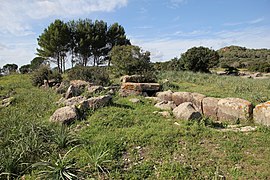Sedda sa Caudeba
The giant tombs of Sedda sa Caudeba A + B (also called Sedda Caudeba, or Sedda 'e sa Caudeba A + B) are only a few meters apart, south of Collinas in the province of Medio Campidano in Sardinia . The ones in Sardu Tumbas de sos zigantes and in Italian plur. Buildings called Tombe dei Giganti are among the latest megalithic structures in Europe . Most of the 321 known giant tombs are monuments of the Bronze Age Bonnanaro culture (2,200–1,600 BC), the forerunner of the nuragic culture .
Type sequence
Structurally, giant tombs appear in two variants. The systems with portal steles and monolithic exedra are of the older type. In later systems, the exedra consists instead of monolithic blocks, of a square facade, clearly raised in the middle, made of processed and layered stone blocks. The two plants of Sedda sa Caudeba cannot be identified because their exedra have not been preserved.
Giant grave A
Gigantengrab A is the better preserved one. It is dated 1600–1400 BC. It is an example of Nuragic architecture that evolved from the Neolithic dolmens . Only the 7.3 m long burial chamber of Tomba di Giganti A has survived. The finds from the grave suggest that it is a man's grave.
- Sedda sa Caudeba
Giant grave B
Giant tomb B is not as well preserved as tomb A, but it covered a larger area, as evidenced by the foundation stones of the chamber and the hilltop, which are the only ones that have survived. The excavations yielded fragments from large pots.
See also
literature
- Jürgen E. Walkowitz: The megalithic syndrome. European cult sites of the Stone Age (= contributions to the prehistory and early history of Central Europe. Vol. 36). Beier & Beran, Langenweißbach 2003, ISBN 3-930036-70-3 .
Web links
Coordinates: 39 ° 38 ′ 42.3 ″ N , 8 ° 48 ′ 19 ″ E




